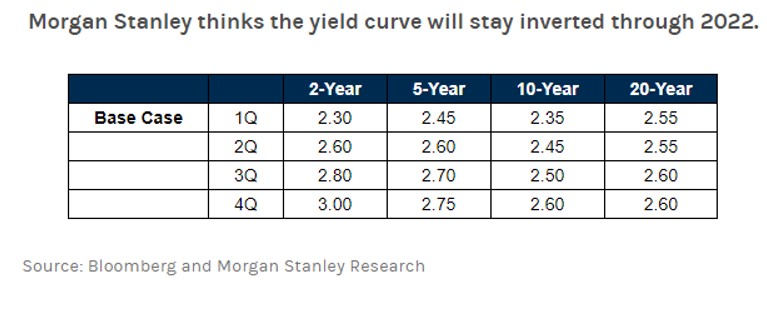Investment Strategies
Inverting Bond Yield Curve Doesn’t Imply Recession – Morgan Stanley

The US bank and wealth management firm examines whether a change in the shape of US government bond yield curves is a red flag for recession, or whether it is a matter that should not unduly worry investors.
An inverted shape of the US government bond yield curve, caused
by how yields on short-dated Treasuries are above those with
longer maturities, doesn’t necessarily imply that a recession is
on the cards, because forces currently in play are unique,
Morgan
Stanley says in a note.
The huge economic disruptions and costs caused by COVID-19
lockdowns, spiking energy costs and rising inflation have been
accompanied by rate hikes from the US Federal Reserve, moving the
Fed funds rate from zero to a corridor of 0.25 per cent to 0.5
per cent. More rate rises are expected. Inflation has spooked
markets. In February, the consumer price index rose 7.9 per cent
from a year ago, the highest rate in four decades.
Banks and wealth managers are trying to work out how to position
clients' portfolios at a time when rising inflation and the
prospect of rising rates is forcing them to re-think asset
allocations. The past decade has seen a flood of money into
relatively illiquid segments such as private equity and credit
amid a drop in yields on conventional government debt and listed
equities.
Recently, yields for two-year Treasuries moved higher than those
of 10-year Treasuries, or what economists call a “2s10s” curve
inversion. Morgan Stanley strategists said they think the
2s10s curve will invert further and sustain that inversion
throughout the remainder of the year. (See chart.)

“Historically, this has signalled an imminent recession. This
time around, however, the inversion has more do with near-zero
interest rates and strong demand for long-term Treasuries than
the health of the economy,” the firm said in a note.
“Overall, the yield curve has become less of a recession
indicator over the last two economic cycles,” Morgan Stanley’s US
chief economist Ellen Zentner said. “And when we look at factors
in the economy that are typically signals of a recession, such as
job growth, retail sales, real disposable income and industrial
production, we don’t see an approaching recession.”
All things being equal, bonds with longer maturities typically
need to pay higher interest rates to compensate investors for the
additional risks that come with owning these fixed-income assets
over time, the bank said. When a yield curve is “normal”, it
slopes upward; the longer a bond’s maturity, the higher its
yield. In the past, an inversion has flagged that investors
collectively see more risk in the immediate future than down the
road.
But the bank said the past two economic cycles haven’t been
typical. “In reality, yield curves flatten for a multitude of
reasons, most of which aren't a reflection of investor views
about slowing growth,” Matthew Hornbach, global head of macro
strategy for Morgan Stanley, said.
The bank said rate rises usually nudge interest rates for other
bonds higher, but the effect isn’t always linear and at present
short-term bond yields are increasing while yields for
longer-term bonds have barely budged. This is because there is
strong global demand for US Treasuries, as well as the US
government’s own bond buying.
“Higher rates don’t always mean recession. The Fed is raising
interest rates to combat inflation and keep the economy from
overheating. While markets often have a knee-jerk reaction to
higher interest rates, many times the Fed has raised rates
without triggering a recession,” the firm said.
Morgan Stanley also argued that banks won’t stop lending,
contrary to what some market watchers may fear. The bank said its
research shows that bank loans grew during the prior 11 periods
of yield curve inversion since 1969. And this year, they project
loans will grow 7 per cent year-over-year.
“In the absence of growth headwinds from geopolitical events,
curve inversion alone would not be a cause of concern for
corporate credit, given healthy balance sheet fundamentals,”
Hornbach said.